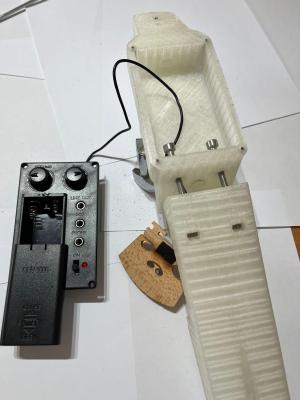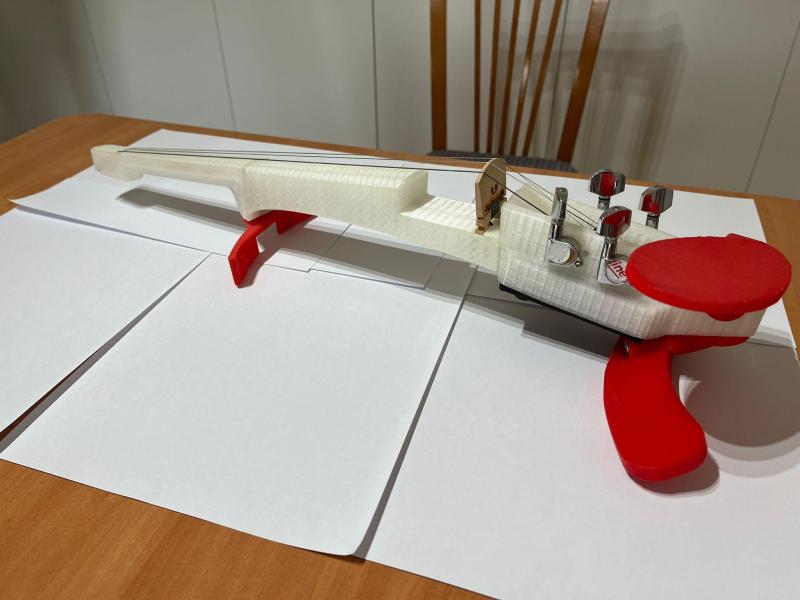We’ve always said that if we had enough money, we’d have a large room that housed every musical instrument we’ve ever been even mildly interested in. While that dream may never come to pass, it would be far more likely to happen if many of the instruments could be 3D-printed, like this electric violin.
 We really like this compact design, which mimics a headless guitar with the tuning pegs down by the bridge. [Carmensr] started with a model on Thingiverse, which uses violin strings wound around electric guitar tuners instead of wooden friction pegs. To further the guitar comparison, the three-piece neck contains a truss rod of sorts.
We really like this compact design, which mimics a headless guitar with the tuning pegs down by the bridge. [Carmensr] started with a model on Thingiverse, which uses violin strings wound around electric guitar tuners instead of wooden friction pegs. To further the guitar comparison, the three-piece neck contains a truss rod of sorts.
So how does it work, though? The magic is in the special bridge, which contains a piezo element. The bridge picks up the strings’ vibrations and sends them to a little pre-amplifier, which creates a signal that can then be used by a program like Audacity or connected directly to a speaker. Be sure to give it a listen in the video after the break.
Of course, there’s no reason not to design and print acoustic violins. It would be fun to experiment with different filaments for different sounds.















Brilliant. I like the novel placement of the tuning gears on the player side of the bridge.
Interesting project but you can get a playable and not awful sounding violin on Amazon for under $50 usd, with a bow and a case and even some rosin. You might try to replicate that, or if you just want to play very casually get one pre made. I guess I do not see the “win” in this. You can get a $15 pickup and preamp on eBay if you want to electrify it. That pushes the cost up into the $65 range.. It would have been interesting hearing someone who can play playing it a bit. You can hear the uber cheap ones contrasted with expensive ones all over you tube, and the thing I mostly walk away hearing is that they are not great, but they are fantastic for the money. One nice guy did a video on how to properly fit the bridge, but if you look on eBay, you can find pre fit bridges for under $10. I tried one and it was a pop in replacement.
Good point, i agree with him.
“I guess I do not see the “win” in this.” … Have you ever heard of the ‘fun’ of doing something yourself? So what if it costs $10 … or $1,000,000? All about doing a neat project yourself for the fun it it :) . For example, I can buy a Ready To Fly R/C airplane for $200. If I built a balsa version from the ground up for $400, I still enjoy the build and the flying. Win Win … Not “I don’t see the win in this!”
Each to their own!
Neat project!
But it has no use. Real use is find a better insurance or do your taxes, that are stuff that gives you inner satisfaction becauses it is real and it counts.
Trying to extract financial gain from a hobby defeats the purpose of a hobby.
Very good answer rclark
I swear, this is the only site where I regularly see presumed-adults needing the concepts of hobbies and fun explained to them.
I think this is the difference between making and hacking.
I see hacking as I want something that would cost more than I can spend and via some cleverness I can get a similar result at a price I can afford.
Making seems have some of the same aspects but without concern for the finished price. You may spend much more to get much less than you can buy for the same money.
Last time I looked the name at the top was hack a day.
But it’s more about making the violin than having it. And besides an electric violin will get you girls (or boys in her case.)
I once made a media computer for my TV with a Cubietruck, Ubuntu, youtube-dl, ffmpeg, PHP and MPV, lots of bash scripts, and a spare large HDD. Took me months to get it kinda running like I wanted. It failed from time to time, I had to SSH in to fix issues, but after several iterations it was working properly.
A friend reminded me that I could have just bought an Android appliance for half the price, and with everything already integrated instead of my awkward rigged, bulky solution.
And I said “and what’s the fun on that?”
If you are looking at the violin at the result, yes, you could have a better result just buying on Amazon. If the learning and the process and the “kudos” are the result, well, posting “I was able to buy a violin on Amazon!” will be a terrible result.
Oh why would anyone think to build something for themselves. Just drop some cash to some foreign agency so that you can look at something you didn’t need to build.
Having had the pleasure of building many things from scratch regardless of “cost”, I applaud anyone else doing the same. To then also publish the journey for others to see is truly wonderful.
I agree, nice project.
Absolut no
how long will this sit on the shelf, unplayed, before the whole thing snaps from plastic fatigue?
given how i approach everything else, i’m surprised i’m so down on home-made instruments but the simple fact of the matter is that it’s hard to play a piece of garbage (learned this the fun way). the process of learning how to play an instrument benefits a lot from a decently well-made instrument that offers a uniform experience over time. it’s very hard to make a decent violin and i simply don’t believe this material is up to that challenge. if i was to make a violin, the very last thing i’d do would be to use plastic in anything other than compression loads! i happen to have made an electric violin almost 20 years ago, and i used a 2×4. and that’s how i would do it today too, even though i have a 3d printer now that i use all the time.
the only instrument i made that i would consider ‘playable’ is a pvc quena (a kind of flute).
i guess the more i use FDM, the more i love it, but conversely, the more sensitive i become to things it isn’t good at. it’s so good at some things! printing the bulk of a body of anything is going to be its weak point, but to do it to a musical instrument that is under tension….yow!